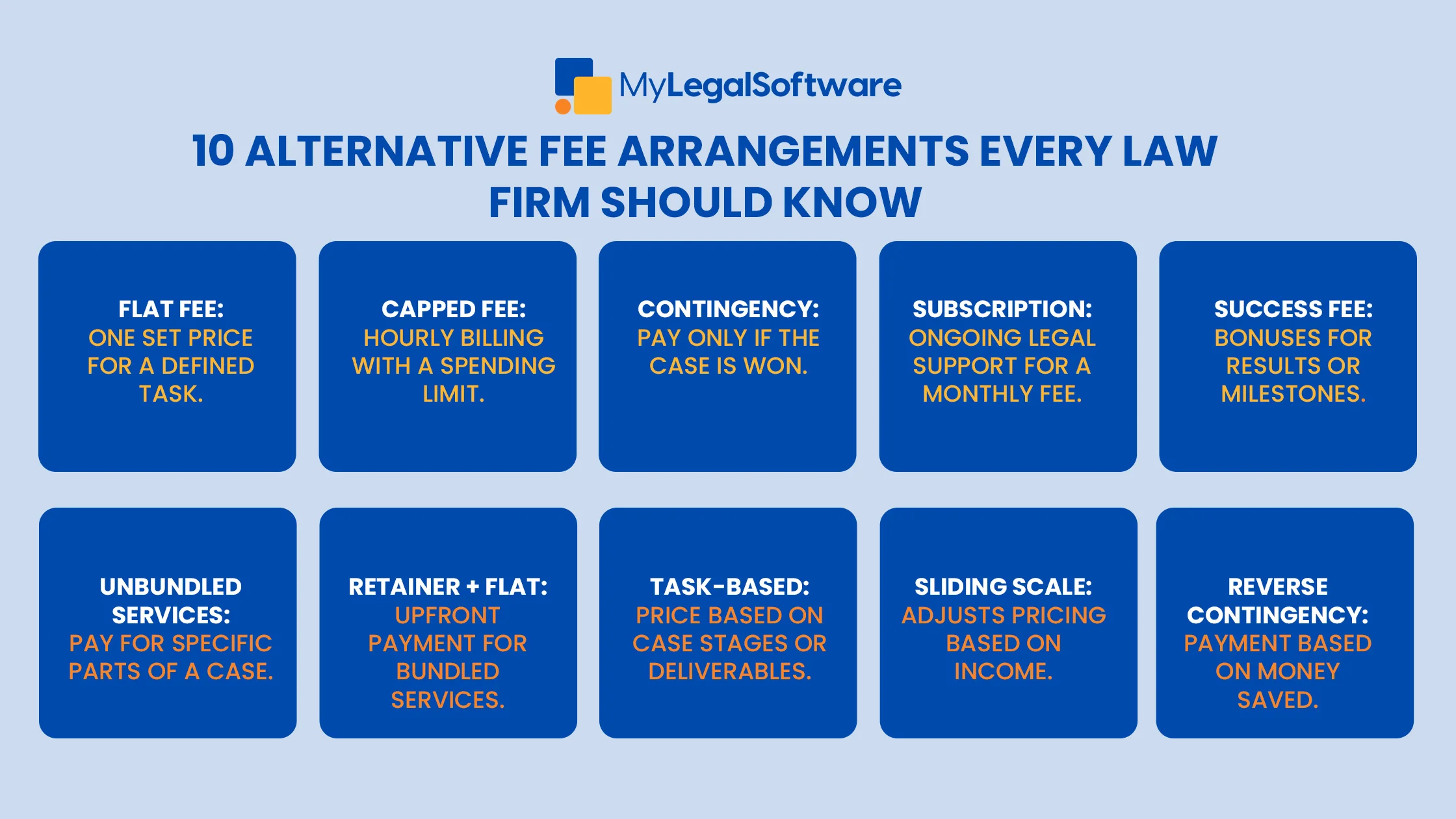The legal world is undergoing a noticeable shift. Clients today, whether individuals or businesses expect more than just legal advice. They want clarity, consistency, and billing that aligns with the results they get.
Traditional hourly billing, with its unpredictability and emphasis on time over value, often leaves clients frustrated and law firms struggling to meet up. That’s why more attorneys are considering alternative fee arrangements for law firms. Firms are adopting these models not just to meet client expectations but to work smarter.
AFAs bring transparency, encourage efficiency, and can even lead to better financial outcomes for both sides. In this guide, we’ll walk you through ten of the most effective types of alternative fee arrangements law firms are using in 2025—along with tips for implementing them successfully.
What Are Alternative Fee Arrangements for Law Firms?
Alternative fee arrangements (AFAs) are billing strategies different from the standard billable hour. Instead of tracking every minute, firms and clients agree on pricing models that are based on the type of work, the desired outcome, or the value provided.
These arrangements can include flat fees, contingency payments, subscription models, or a blend of different models. The idea is to align what the client pays with what they get, not necessarily how long it took.
Alternative fee arrangements for law firms benefit practices of all sizes. Large firms may use them to manage client portfolios more predictably, while smaller firms and solo practitioners often find them useful for building trust and standing out in a crowded market.
Now, let’s explore the most widely used AFAs in the legal industry today.
10 Effective Types of Alternative Fee Arrangements for Law Firms

1. Flat Fee Billing
Flat fee billing is exactly what it sounds like: the client pays one fixed price for a specific legal service. This model works best when the scope of the work is well-defined and predictable. It’s commonly used for services like drafting wills, handling trademark filings, forming LLCs, or filing standard immigration petitions.
Rather than worrying about how long something takes, the client knows exactly what it costs from the start. And for firms, it rewards experience and efficiency.
Pros:
- Gives clients full transparency and cost certainty
- Encourages attorneys to work more efficiently
- Allows for premium pricing when services are delivered quickly
Cons:
- Risk of underpricing complex or unexpected work
- Requires clear scoping at the outset to avoid scope creep
2. Capped Fees
Capped fees are a hybrid approach. Clients are billed by the hour, but there’s a cap on what they’ll pay. It’s a win-win: clients get peace of mind knowing their fees won’t spiral out of control, and firms can still charge for the actual work done up to the maximum limit.
This model is great when the scope is mostly predictable, but there’s potential for surprises. It blends familiarity with flexibility and reduces billing anxiety for clients.
Pros:
- Offers cost control while maintaining hourly flexibility
- Easy for firms to implement within current systems
- Reduces risk of fee disputes
Cons:
- Firms absorb the risk if the case goes beyond expectations
- May discourage thoroughness as work nears the cap
3. Contingency Fees
In a contingency fee arrangement, the lawyer only gets paid if the client wins or settles the case. Payment is usually a percentage of the final recovery. It’s a common model in personal injury law, employment disputes, and debt recovery cases.
This arrangement directly ties the lawyer’s success to the client’s outcome, which builds trust, especially for clients who can’t afford legal fees upfront.
Pros:
- Makes legal help accessible to clients without upfront cash
- Motivates attorneys to achieve the best results
- Fully aligns the lawyer’s and client’s financial interests
Cons:
- Not allowed in certain areas of law (like criminal or family law in many jurisdictions)
- Compensation can vary widely
- Potential conflicts over when or how to settle a case
4. Subscription-Based Legal Services
Just like Netflix, but for legal help. Subscription models allow clients to pay a flat monthly or annual fee for ongoing legal support. This model works especially well for small businesses, startups, or freelancers who need regular advice on contracts, compliance, or employment matters.
For law firms, it means predictable income and longer-term relationships. For clients, it means accessible legal guidance without fear that every phone call comes with a bill.
Pros:
- Creates steady revenue for the firm
- Builds loyalty through ongoing access and support
Cons:
- Requires firms to price carefully to remain profitable
- May not work for all practice areas
- Demands consistent delivery of high-quality support
5. Success Fees / Performance-Based Billing
Success fees reward law firms for meeting or exceeding agreed-upon milestones. On top of a base fee, the firm receives an additional bonus for achieving specific outcomes, like winning a motion, closing a deal, or securing a favorable ruling.
This model shares the risk and reward between client and attorney and works well in complex transactional or litigation work where success can be clearly defined.
Pros:
- Encourages high performance and tangible results
- Firms can charge more for great outcomes
- Makes the lawyer a true partner in the client’s success
Cons:
- Success must be clearly defined in advance to avoid disputes
- Can add pressure to prioritize winning over other client needs
- Not practical for all case types
6. Unbundled Legal Services
Also called limited-scope representation, unbundled legal services let clients pay only for specific parts of a case. Instead of full-service representation, they might hire a lawyer just to draft documents, review contracts, or coach them before a court appearance.
This model gives budget-conscious clients access to legal expertise while allowing attorneys to focus on higher-value work. It’s especially useful in family law, landlord-tenant matters, and small claims cases.
Pros:
- Expands access to legal help for clients with limited budgets
- Lets attorneys concentrate on what they do best
- Offers flexibility to clients who want more control
Cons:
- Must be carefully scoped to avoid malpractice issues
- Requires very clear communication around boundaries
7. Retainer + Flat Fee Hybrid
This model blends upfront retainers with flat fees for specific legal services. The client pays a set amount upfront, which covers a defined list of services. Any work beyond that is billed separately.
It’s a practical option for firms that want predictable income while still offering clients transparency. It also allows firms to package common services, like business formation, compliance reviews, or document drafting, into a retainer-based bundle.
Pros:
- Provides upfront cash flow and service clarity
- Builds long-term relationships with clients
- Gives clients predictable pricing on core services
Cons:
- Requires careful pricing of bundled services
- May not address every client need within the package
8. Task-Based Billing
Rather than billing for time, task-based billing breaks down a legal matter into distinct stages, each with its own set price. This model is especially helpful in litigation, transactional work, and regulatory filings.
It helps clients see what they’re paying for and when. For firms, it supports better project management and can streamline invoicing.
Pros:
- Brings clarity through deliverables and milestones
- Lets firms price based on effort and value per task
- Creates a more predictable payment schedule
Cons:
- Requires detailed scoping of each task or phase
- May not fully account for unexpected complications
9. Sliding Scale Fees
Sliding scale fees adjust pricing based on a client’s ability to pay. They’re typically used in practice areas like immigration, family law, and nonprofit advocacy, where access to representation is critical, but budgets vary widely.
Firms that adopt this model often use income brackets or financial disclosure to determine what a client pays. While not a fit for every firm, it’s a socially impactful way to expand access to legal help.
Pros:
- Makes legal services accessible to lower-income clients
- Helps firms serve a broader, more diverse population
- May open up pro bono credit or grant opportunities
Cons:
- Adds administrative tasks like income verification
- May not be viable for firms with tight margins
- Requires careful quality control and ethical oversight
10. Reverse Contingency Fees
Reverse contingency fees involve clients paying attorneys based on money saved rather than money recovered. This model is particularly common in tax, debt, and regulatory work, and it pegs the lawyer’s fee to a percentage of the cost saved.
It’s all about measuring the value of what didn’t happen: fines, penalties, or liabilities that were reduced or eliminated through legal action.
Pros:
- Aligns attorney effort with client cost savings
- Makes the value of legal advice easier to quantify
Cons:
- Requires a solid baseline for cost comparison
- Harder to apply in subjective or non-monetary cases
Why More Firms Are Adopting Alternative Fee Arrangements in 2025
1. Clients Want Predictable Pricing
Today’s clients expect the same transparency from law firms that they get from other service providers. That means clear pricing, fewer surprises, and a direct link between what they pay and the value delivered. AFAs offer exactly that, and firms that don’t adapt risk losing business to those that do.
2. Legal Tech Makes AFAs More Practical
Modern case management platforms, like MyLS, make it much easier to estimate scope, track tasks, and bill creatively. With the right tools, law firms can confidently roll out flat fees, automate client updates, and monitor project timelines, making alternative fee arrangements not just possible but profitable.
3. AFAs Help Firms Stand Out
In competitive markets, firms that offer AFAs often win clients who are tired of unpredictable hourly bills. A transparent pricing model can become a key differentiator, especially for solo practitioners and small firms looking to stand out.
4. Regulators Support the Shift
Bar associations across the country are recognizing that flexible billing can improve access to justice and client satisfaction. Many now explicitly encourage non-hourly models, especially in areas where underserved populations face barriers to representation.
Best Practices for Implementing Alternative Fee Arrangements

-
Start with What’s Predictable
Don’t overhaul your whole billing system overnight. Begin by applying AFAs to routine or repeatable services where scope and cost are easier to estimate. This reduces risk and builds confidence on both sides.
-
Define Everything in Your Engagement Letters
For AFAs to work, the client must know exactly what they’re paying for. Your engagement letter should spell out what’s included, what’s not, and what happens if the scope changes midstream. This helps prevent misunderstandings and fee disputes.
-
Train Your Team to Think in Outcomes
If your staff is used to tracking billable hours, you’ll need to shift their mindset. Encourage them to focus on client outcomes, efficiency, and value delivery instead of just time spent. The right cultural shift makes a big difference in how AFAs are executed.
-
Listen to Your Clients
Ask clients how they feel about your pricing, what works, what’s confusing, and what they’d like to change. Use that feedback to adjust your AFA offers. Over time, this kind of responsive pricing strategy builds stronger relationships and a better client experience.
Final Thoughts
Alternative fee arrangements for law firms aren’t just a trend; they’re a long-overdue evolution in how legal services are delivered and priced. As more clients demand value, transparency, and partnership, firms that embrace AFAs will be better positioned to thrive.
Of course, it takes planning and may require new tools and a mindset shift. But in return, it yields stronger relationships, steadier revenue, and a sharper competitive edge.
Whether you’re a solo attorney or managing a mid-size firm, systems like MyLegalSoftware give law firms the tools to make AFAs easy to implement and manage. From automated workflows and client portals to flat-rate billing and task tracking, MyLS supports any fee structure.
Start your free 14-day trial and see how better billing can transform your practice.
Frequently Asked Questions
-
What are the best alternative fee arrangements for small law firms?
-
Are alternative fee arrangements for law firms ethical?
-
How do I price flat fee services?
-
Can one firm offer multiple AFA types?
Flat fees, subscription services, and retainer + flat fee hybrids are very practical. They’re easy to implement, deliver predictable income, and help small firms compete on value.
Yes, as long as they follow local professional conduct rules. In fact, many bar associations support AFAs because they improve access and align lawyer-client incentives.
Start by reviewing time and cost data from past matters. Then, factor in client value, potential risks, and a healthy margin. The goal is to price for results, not just effort.
Absolutely. Many firms use different models depending on the practice area, client profile, or matter complexity. The key is matching the model to the work.








